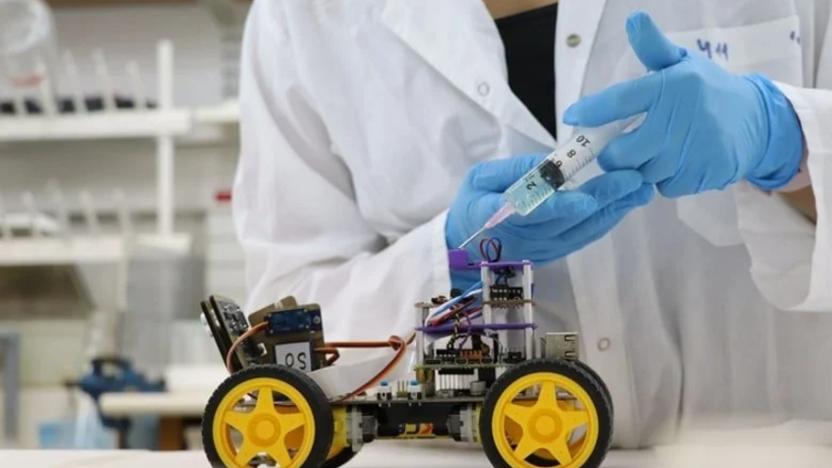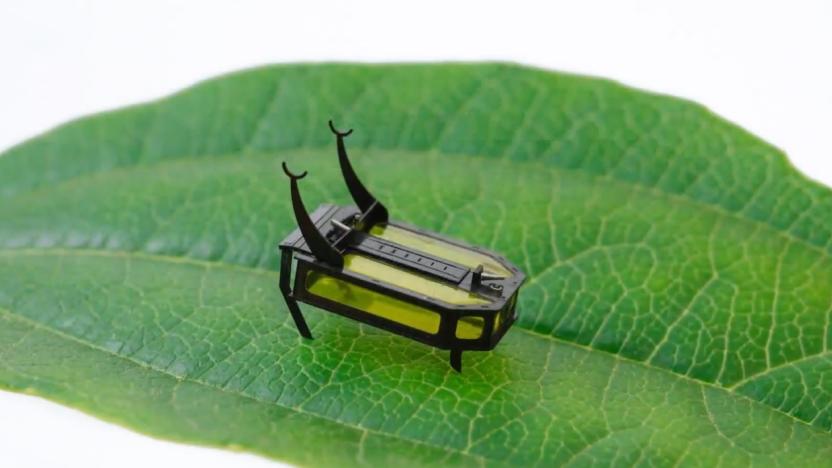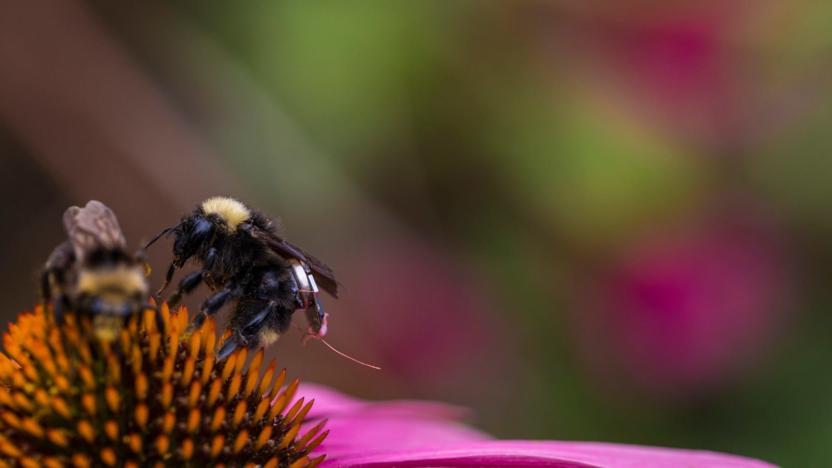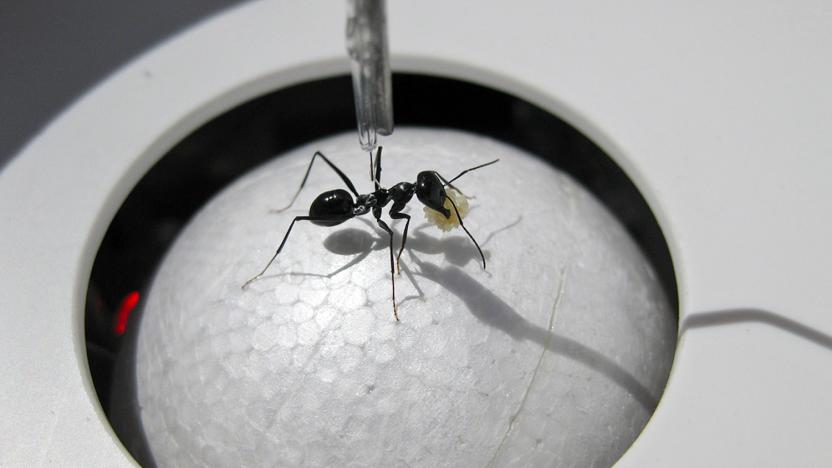insect
Latest

Scientists gave a robot a sense of smell with locust antennae and AI
Researchers from Tel Aviv University say their "bio-hybrid" robot could one day be used to detect drugs and explosives.

Insect-like drones can take a beating and keep flying
Researchers have built drones whose insect-like agility and toughness helps them fly through tight spaces — and take some punishment, too.

This tiny robotic beetle travels for two hours without a battery
This tiny, autonomous robotic beetle runs on liquid methanol.

App allows citizen scientists to track monarch butterfly migration
If you've ever pulled out your phone to take a picture of a butterfly, researchers want your help. A team from the University of Maine is using an app that lets citizens scientists along the East Coast take photos of monarch butterfly migration sites and log details about where they're found. The responses will be compiled in an online database and help researchers determine if their monarch migration predictions are accurate.

Insects could be extinct within a century, scientists say
Insects are dying so rapidly, they could disappear within 100 years, according to the first global scientific review on their decline. A third of species are endangered and more than 40 percent face the threat of extinction in the next few decades, according to the study, which was published in the Biological Conservation journal.

Bees with tiny sensor backpacks could help farmers track crops
Farmers can use drones to monitor their fields, but they have their limits when they can rarely fly for more than 20 to 30 minutes at a time. University of Washington researchers might have a smarter way: recruit some insect friends. They've developed sensor backpacks that are light enough (about 0.0035 ounces) and efficient enough to ride on a bumblebee, but capable enough to collect data for seven hours at a time over relatively long distances. You wouldn't have to replace packs very often, either, as they could just fly into their hives to wirelessly recharge and transmit data.

Robotic insect takes flight powered by frickin' laser beams
Miniscule robotic drones might be the future, but they've been tricky to get off the ground. Until now, any wing-flapping insect robot had to have a power source, making it too heavy to lift off with its tiny wings. Now, however, researchers at the University of Washington have found a way to transmit power to a flying robotic insect (lovingly dubbed RoboFly) via laser, obviating the need for a separate power supply.

Ants run on tiny treadmills to help track their behavior
It's relatively easy to study animals' movement by plunking them on treadmills, but how do you do that with a creature as small and fragile as ants? Build a tiny custom treadmill, that's how. Scientists have crafted a contraption that let them study the homing behavior of ants on a treadmill for the first time. In many ways, it amounts to an optical mouse flipped on its back. An air-cushioned styrofoam ball serves as the actual running surface, giving the ant freedom to move as far as the tether (dental floss) allows without falling off; optical sensors from computer mice track their gait, speed and changes in direction.

ICYMI: This rock-armored insect could change medicine
try{document.getElementById("aol-cms-player-1").style.display="none";}catch(e){}Today on In Case You Missed It: Researchers at the University of California, Berkeley discovered that an insect called the caddisfly spins strong, stretchy silk that works like a biological sticky tape. The caddisfly uses it to attach stones to its body to protect it underwater; humans are more interested in the fact that the waterproof adhesive might have medical applications. The publication Deep Look made a great video of the bug's underwater life that's worth a full watch if you're interested.

DARPA gives an R/C chopper the legs of a dragonfly
DARPA has revealed a new kind of landing gear that allows helicopters to land on inclines and uneven terrain, a feat that's generally impossible using traditional landing skids. Rather than the fixed landing gear that most helicopters sport, this new set of four articulated legs is designed to work much like an insect's. Each leg is outfitted with force feedback sensors that tells it how much pressure to exert in order to keep the aircraft level, regardless of terrain.

Tiny robotic insect can jump on water like a strider
Harvard's Wyss Institute for Biologically Inspired Engineering has a history of creating tiny, insect-inspired robots, and its latest one can stand and jump on water just like a strider. The Wyss group has teamed up with scientists from Korea's Seoul National University and Harvard's John A. Paulson School of Engineering and Applied Sciences to design a machine that can mimic a water strider's "most complex maneuver." In order to accomplish that, they captured actual insects jumping on camera and studied their movements closely to determine their secret.

Watch the first steps of a robot inspired by stick bugs
They grow up so fast, don't they? It was just a few years ago that HECTOR the stick bug robot was little more than a twinkle in Bielefeld University's eye, and it's already taking its first steps. Okay, so this isn't quite a tear-jerking moment, but it's still an important achievement in robotics. As you'll see in the video below, all of HECTOR's six insect-like legs move independently while reacting to unexpected changes in terrain. They shift to maintain balance on slippery ground, and raise themselves above small obstacles the moment they sense resistance.

Small winged bot flies autonomously for nine minutes, still can't find a mate
Many robots can fly, but only a few forsake rotors for more natural, if inefficient means of propulsion. These flapping bots have interested folks at the Delft University of Technology for many years, and their latest dragonfly-like effort has achieved what they're calling a first among winged machines: Autonomy. The DelFly Explorer is larger than creations past, but still weighs only 20g (0.7 oz), or the equivalent of roughly four paper airplanes. To flutter freely without human aid, the Explorer marries a barometer and gyroscope with two cameras for eyes, and a microcontroller for a brain. Mix that with some clever coding, and the automaton can take off and navigate its surroundings unassisted until its nine minutes of battery life are up. The DelFly crew imagine their bots could have both fun and functional uses in the future, but for now are busy adding multi-room navigation. At which point, DelFlies will be the perfect scouts for Google's terrifying robot army.

Harvard University's robotic insect takes its first controlled flight (video)
There's hardly a shortage of animal inspired robots, but few are as tiny as Harvard's autonomous RoboBee. The robotic insect has been around for a while, but researchers at the Wyss Institute for Biologically Inspired Engineering only recently managed a minor breakthrough: controlled flight. Using new manufacturing and design processes, the team has managed to keep the coin-sized bug aloft by independently manipulating the robot's wings with piezoelectric actuators and a delicate control system. "This is what I have been trying to do for literally the last 12 years," explains Professor Robert J Wood, Charles River Professor of Engineering and Applied Sciences. "Now that we've got this unique platform, there are dozens of tests that we're starting to do, including more aggressive control maneuvers and landing." There's more to be done, however. The tiny machine still requires a tether for power and control, and researchers are still studying nature to suss out how insects cope with flying through wind and the elements. Eventually, the team hopes to outfit the RoboBee with lightweight batteries, an internal control system and a lighter chassis. For now, however, they're just happy to learned to steer. Check out the insect in action after the break.

Alt-week 10.13.12: is the Universe a simulation, cloning dinosaurs and singing mice
Alt-week peels back the covers on some of the more curious sci-tech stories from the last seven days. Are you reading this? Seriously, are you? Sure, we know you think you are, but what if you're just a sub-feature of a complex computer program. A sprite, nothing more than the creation of software. The problem with this question is, how would you ever know? You wouldn't, right? Well, not so fast there. Turns out, maybe there is a way to unravel the matrix (if there is one). It'll come as no surprise, that this is one of the topics in this week's collection of alternative stories. Think that's all we got? Not even close. We'll explore the truth behind cloning dinosaurs, as well a rare performance by singing mice -- all before dinner. Or is it really dinner? This is alt-week.

Armchair Darwinians discover new insect species on Flickr
Entomologist Shaun Winterton has discovered a new species of Malaysian Lacewing from the comfort of his computer. Idly browsing Flickr, he came across Guek "Kurt" Hock Ping's snap of an insect taken while hiking in the Malaysian jungle, which bore an unfamiliar black-and-blue pattern along its wings. When his colleagues couldn't identify the markings, he realized he was staring at a new species and hurriedly emailed the photographer -- who, a year later, had captured one of the elusive creatures. Sent to Simon Brooks at the Natural History Museum, the suspicion was confirmed. The armchair explorer named it Semachrysa jade after his daughter and promptly used Google Docs to co-author the paper with Guek and Brooks on opposite ends of the world. If your mom complains that you're spending too much time on your computer, you can tell her you're searching for strange life-forms and old civilizations with a straight face. [Image Credit: Guek "Kurt" Hock Ping, Flickr]

Chinese microbot walks on water, skims the surface of insect-inspired design
Bugs are creepy. You don't need to be an entomophobe to empathize with that sentiment. But bugs are also inspiring -- to researchers in China, that is. Taking a cue from nature, a team of engineers from the country's School of Chemical Engineering and Technology have devised a microbot weighing just 0.02 lbs (11 grams) that can repeatedly jump across the surface of water without tanking. How'd they do it? Well, by using a highly repellent foam coating, the strider-like bot's legs are able to stay afloat with every 5.5 inch (14 cm) leap it makes, buffering the force that would normally plunge it below the H20. The creation of this hydrophobic mini-insectoborg isn't exactly the first of its kind, other aquatic gliders have come before, but this itty bitty fella's the first to successfully and repeatedly hop along an aqueous top. Unfortunately, there's no video demo for you to feast your eyes upon, so you'll just have to take our word for it.

Cyborg cockroaches inch closer to reality, blame science
Few things on this planet are more indestructible than the lowly cockroach -- except, of course, a cyborg cockroach. That's what researchers at Case Western Reserve University are looking to create, and they're a lot closer than you may think. In fact, chemistry professor Daniel Scherson has found a way to harvest energy from the chemicals swimming within these insidious insects, meaning that they may soon be able to create robot cockroaches with a more reliable power source. To do this, Scherson and his team incorporated enzymes capable of converting a cockroach's food intake into electrons, which can then be funneled through a fuel cell to generate electricity. Unlike similar developments, Scherson's technique doesn't rely on an external source like light, movement or batteries. All you need is a cockroach and a steady food supply -- basically, a college dorm room. [Image courtesy of The Life Files]

HECTOR insect-inspired hexapod walking robot is a smooth operator (video)
We've seen some rather nightmare-inducing robots inspired by insects, but, once again, the folks at Germany's Bielefeld University have managed to turn something inherently creepy into a rather lighthearted affair. HECTOR, or hexapod cognitive autonomously operating robot, was designed to help its creators understand how exactly real animals manage to move so gracefully. Physically speaking, HECTOR sports six legs, with 18 joints in total, that protrude from an exoskeleton made of carbon fiber reinforced plastic. Its legs are given a rather life-like range of motion provided by a special set of "elastic joint drives" and a series of "biologically inspired" algorithms, and its exoskeleton can carry a load weighing 30 kilograms -- the robot itself weighs a mere 12 kilograms. What's more, HECTOR's built to learn from its experiences. Okay, so a three foot robotic insect that can carry nearly three times its weight does sound kind of creepy in retrospect, but HECTOR really does have some smooth moves. You can see at least one of its legs in action after the break.

EPFL's fly-inspired 3D camera takes omnipresence to the third dimension (video)
Just in case you were concerned that the 3D revolution hadn't yet taken over the scientific research field, EPFL is here to convince you that all is well. Researchers from a pair of EPFL laboratories have recently invented a fly-inspired dome camera that's not only loaded down with cameras to snag views from (nearly) all angles, but also equipped with an output algorithm that constructs a bona fide 3D image. The trickeration lies within the hardware platform, which calculates depth on each camera image and then reconstructs a 3D visual based on how far away things truly are. That's a far more sophisticated approach than the stereoscopic one used on existing 3D televisions, as the depth would (theoretically) change as your angle of view changed. There's an outstanding patent application on the approach, and if the world at large latches on, we could see this thing used for "video surveillance, movie making, and creating backgrounds for video games." Among other things, of course. A demonstrative vid awaits you just after the break.















